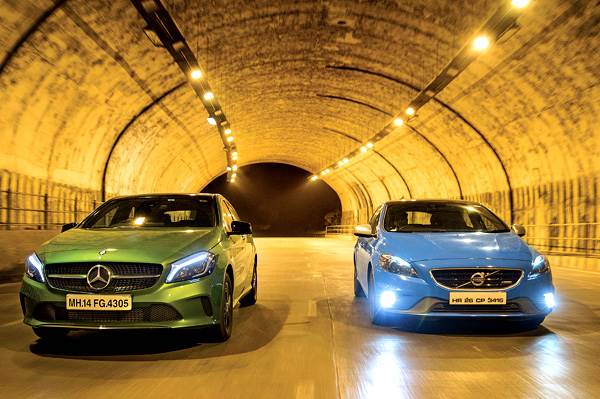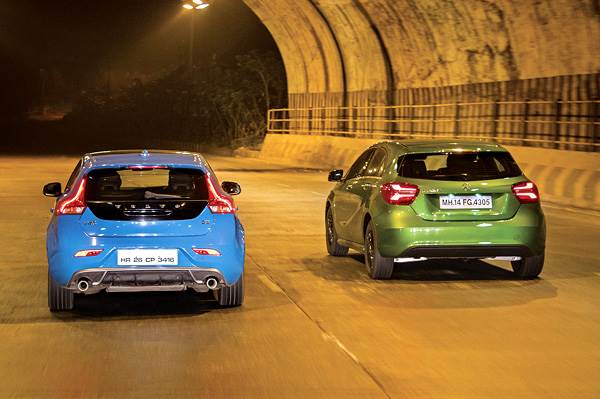Luxury hatchbacks really have their work cut out for them. They bear on their svelte little shoulders the weight of not just a prestigious badge and its heritage, but also the pressure to convince buyers to make an emotional decision, rather than a practical one. Quite a tall order, when you consider you could buy a huge executive sedan or even a seven-seat SUV for the same money. These hatchbacks need to have an edge, and they aim to do it with technology, style, quality and driving prowess.
The most stylish of the lot has arguably always been the Mercedes-Benz A-class, and it has now been given a facelift that only ups the glam quotient. But then, many would argue that the sleek Volvo V40 launched earlier this year, is just as pleasing to the eye. Neither car has a particularly good back seat, but they’re both crammed full of tech and luxury trappings befitting their respective badges. Both of them want to tug at your heartstrings, and ultimately win over your head as well, but which do we think is better?
OOH LA LA
Since Mercedes has already updated the A-class’s mechanicals twice since its May 2013 launch – first the suspension and then the more powerful ‘200’ diesel engine – this update is purely cosmetic. The original car was pretty enough as is, but you’ll be happy for the changes nonetheless. The headlamps and tail-lamps are now full-LED and have different detailing inside, there are new bumpers at both ends, the tailpipe is now hidden behind the rear bumper and you’ll notice the new badge that says ‘A 200d’ rather than ‘A 200 CDI’. And though 17- and 18-inch alloy wheels are still on the options list, 16-inchers are now the default size, in the interest of better ride quality. They look a bit small inside their 205/55 R16 tyres, but Mercedes has cleverly painted them black to help disguise that a bit. The A-class’s sexy proportions remain, of course, with a long, slightly drooping bonnet, a somewhat abrupt, rounded rear and aggressive cuts down its side. The new Albait Green paint is pretty racy too, right?

But then so is this boldly named ‘Rebel Blue’ shade on the V40. Volvo may have originally launched the hatch in its rugged ‘Cross Country’ variant, but this regular version looks a lot cleaner and is a little easier on your wallet too. This one even has the aggressive R-Design body kit and 17-inch ‘Ixion’ wheels, which add a little bit of menace. Like the Merc, it too has a tipped-forward stance, but you’ll notice the Volvo’s profile has a smoother flow to it, with a shoulder line that curves upwards near the rear, ending in a very raked rear windshield and some fabulous tail-lamps. What it doesn’t have is the ‘bling’ factor of the A-class, relying more on good proportions than shiny details to get your attention. There are still a few cool bits though, especially at the back, where the blackened tailgate and aggressive diffuser show you it means business.
SPORT PLUS
Black interior themes are the norm here, and it actually works quite well in these driver-focussed sporty hatchbacks. Still, both cars do their bit to liven things up. The A-class uses different colours and textures to very good effect. The seats are part double-stitched leather, part fabric with green inserts, and even the door pads are very well detailed. There’s a beautiful new soft-touch material on the dash and quality, in general, is top notch. Much like in the B-class facelift, you now get Mercedes’ new steering wheel, dials and high-res COMAND interface in a new, smarter-looking 7.0-inch screen – a welcome update after the clunky, cheap-looking old unit.

Quality inside the Volvo is not quite up there with the Mercedes, but is still nothing to complain about. There’s a generous application of chrome all around to break up the monotony and Volvo’s trademark ‘floating’ centre console with a cubbyhole behind it is a neat touch too. You’ll also love the configurable, all-digital instrument cluster, but overall, the V40’s cabin lacks the pizzazz of the A-class. The other sore point is the small infotainment screen and its old-school interface; it’s not as easy to use while on the move.

In this spec, the two are quite closely matched on equipment too, but there are some odd omissions in both. The V40, for example, does without paddle shifters for its gearbox, and though it has front and rear parking sensors, there’s no camera. The A-class does get a camera, but misses out on sensors altogether, and gets a manual air-con. And though it’s not an essential, it’s good to see the A 200d has proper drive modes to choose from, including an ‘Individual’ mode that lets you set the powertrain, AC, stop-start system and steering to either Comfort, Eco or Sport. The V40 does get stop-start too, but only a Sport mode you can select via the gear lever.
FRONT BIASED
These are hatchbacks, and so reasonably, you can’t expect a lot from the back seats. Both are tailored for just two, with the benches carved into two individual buckets. Neither has a lot of headroom, and though legroom is decent, the Volvo has an edge here and also when it comes to width. In fact, there are even small cubbyholes on either side of the seat, and though the rear quarter glass is small, it lets the cabin feel a little more airy than the Merc’s. Rear visibility too is slightly better in the Volvo, aided by larger, further reaching mirrors; the A-class’s ones simply don’t show you enough.

The front seats are what these cars are all about, and each has its own strengths. The A 200d’s snug bucket seats are incredibly supportive and placed low down. The centres are soft and the sides are firm, which works well to hold you in place. Thigh support is a little short, however, and the driving position can be a little awkward for some. It’s also worth noting that though the driver’s seat is electric and gets a memory function, the passenger seat is manual.
Both the V40’s front seats are powered, and unlike the A-class, the focus is decidedly less sporty. They’re bigger and better suited to larger frames, the cushioning is softer and more comfortable and thigh support is a little better too. The V40 also has a larger and better shaped boot and, unlike the A-class, the space-saver spare tyre doesn’t eat into the luggage area.
THE MAIN EVENT
Aside from looking good, it’s important for their owners that these cars drive well too. Let’s start with the A-class, which is a very different car from the one originally launched. The new ‘200d’ version of Merc’s 2.1-litre, four-cylinder engine is a huge improvement over the old 180 CDI, with a more substantial 134bhp and 30.6kgm driving the front wheels. The Volvo’s 2.0-litre, five-cylinder D3 motor, however, simply has more – 148bhp and 35.7kgm. By itself, though, the A-class feels powerful enough, with a nice, linear delivery of power and a most excellent seven-speed dual-clutch gearbox. The first two gears are incredibly short to whisk you up to speed quickly, and it’s not so much of an issue when you’re going slowly, as the shifts are barely perceptible. It’s decently refined at low revs but sounds quite gruff when it’s revved up.

The Volvo engine is louder, but at least it sounds a little nicer when you rev it up. It has a very different character to the Merc, with a bit more lag, followed by an immense whack of power; you’ll even get torque steer if you push too hard. Once you learn how to modulate the throttle, it’s actually quite thrilling, but the power spike can be annoying day to day. The big letdown is the gearbox, a six-speed torque-converter, which is nowhere near as responsive nor as quick with its shifts. The result is, despite the power advantage, they accelerate from a standstill at almost exactly the same rate. Even for overtaking, the kickdown times are less than half a second apart.
The other thing that’s changed significantly since the original A-class is the ride quality. The suspension has been raised and retuned and the wheel size reduced with taller-profile tyres, and the payoff is that one of the harshest riding compact luxury cars has become one of the best. You can definitely feel the inherent firmness of the suspension but the tyres take the edge off sharp bumps really well. There’s a fair bit of up and down movement on uneven surfaces and the A-class still doesn’t enjoy that all-conquering ride of bigger Mercs. Handling is nice and sharp though, and owners will enjoy chucking the A 200d around corners.
The Volvo is quite a lot of fun to drive too. The steering is lighter and the suspension a little softer, so it’s not quite as tack-sharp as the Mercedes. You get a bit of body roll when you push it and the steering robs it of a little confidence when you’re on the limit; you just have to be more alert to enjoy it. It does ride quite well though and the suspension feels marginally more settled but the lower profile tyres find it hard to cope with bad bits of tarmac and combined with the softer setup, the V40 feels a little clunkier over ruts than the A-class.
SELF-DRIVE SELECTION
That this is a closely fought battle is no surprise. These two cars have exactly the same modus operandi and their execution of it is almost the same too. At Rs 27.7 lakh, the Volvo is a little more expensive than the Rs 25.9 lakh A 200d, but then you can sacrifice the R-Design pack and a little equipment for the lower V40 Kinetic trim, which costs Rs 24.75 lakh, so they’re closely matched there too. The Volvo is a surprisingly well-rounded car in the inherently compromised package of a hatchback. It’s spacious, comfortable and has a big boot, and on top of all that, it looks really handsome. Its punchy engine and frisky handling makes it quite a thrill to drive, and it’s very well built too. The A-class loses out in a few areas, namely space, practicality and a bit of equipment. But where it matters most, it scores big. It’s a sharp handler, its looks draw attention, its interior feels special and it’s got a competent powertrain. The V40 may be the more sensible choice, but the A-class is the emotional decision you will want to make.







Comments
Member Login
Personal Details
No comments yet. Be the first to comment.